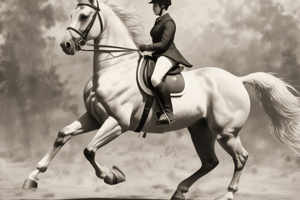Podcast
Questions and Answers
What is the primary function of the legs in Dressage?
What is the primary function of the legs in Dressage?
- To extend the horse's neck
- To slow down and turn
- To ask the horse to go forward or sideways (correct)
- To hold the reins and communicate with the horse
What is the purpose of using the seat in Dressage?
What is the purpose of using the seat in Dressage?
- To signal the horse to slow down or canter (correct)
- To help the horse navigate jumps
- To aid in sharp turns and quick changes in direction
- To provide an alternative to using the reins
What is the function of the hands in Dressage?
What is the function of the hands in Dressage?
- To provide additional leg aids
- To slow down or stop the horse
- To communicate with the horse using the reins (correct)
- To extend the horse's neck and back
What is not considered an aid in Dressage?
What is not considered an aid in Dressage?
When is it acceptable to use your voice as an aid in Dressage?
When is it acceptable to use your voice as an aid in Dressage?
What is the purpose of using a whip or spur in Dressage?
What is the purpose of using a whip or spur in Dressage?
What is the primary characteristic of a canter?
What is the primary characteristic of a canter?
How can you identify the correct canter lead when riding?
How can you identify the correct canter lead when riding?
What is the first step in initiating a canter?
What is the first step in initiating a canter?
What should you do if you realize you have the wrong canter lead?
What should you do if you realize you have the wrong canter lead?
Why is it important to check the horse's bending when initiating a canter?
Why is it important to check the horse's bending when initiating a canter?
What is the correct placement of the inside leg when initiating a canter?
What is the correct placement of the inside leg when initiating a canter?
Why is it important to be specific with your aids when initiating a canter?
Why is it important to be specific with your aids when initiating a canter?
What should you do if the horse is having difficulty with one canter lead?
What should you do if the horse is having difficulty with one canter lead?
How can you identify the correct canter lead when observing the horse's legs?
How can you identify the correct canter lead when observing the horse's legs?
Flashcards are hidden until you start studying
Study Notes
Aids in Dressage
- Aids are used to communicate with the horse in Dressage, with the main aids being legs, seat, and hands.
- Legs are used to ask the horse to move forward or sideways, such as in leg-yield, shoulder in, or half pass.
- Seat is used in different situations, including:
- Slowing down
- Going into the canter
- Going backwards
- Making turns
- Hands are used to hold the reins, allowing communication with the horse through:
- Small squeeze or pull
- Moving the reins left or right
- Giving reins to extend the horse's neck
- Voice can also be used as an aid, including:
- Clicking the tongue to go faster
- Saying 'Whoa' to slow down
- Rewarding with 'good boy'
- Correcting with 'no!'
- Note: Voice aids are not allowed in competitions, but may be used discreetly in training.
Additional Aids
- Whips and spurs are not considered primary aids, but rather additional tools to support leg aids.
- They are used only when the horse does not respond well to other aids.
The Canter Gait
- The canter is a 3-beat gait where a horse can throw either the left or right leg out.
- There are two types of canter: left side canter and right side canter.
Characteristics of Canter
- The canter starts with the outside hindleg, followed by the two diagonal hind and front legs, and finally the inside frontleg.
- The canter ends with a moment of suspension, where all four legs are off the ground.
Identifying the Correct Canter
- To identify the correct canter, look at the inside frontleg, which appears to move more forward than the other leg.
- In a left canter, the left frontleg is thrown out more, and in a right canter, the right frontleg steps out more.
- When riding, observe the horse's shoulders; the shoulder of the canter you are in will move more forward.
Initiating the Canter
- To initiate the canter, follow these steps:
- Start with a sitting trot.
- Turn the horse slightly in the direction of the desired canter.
- Place the outside leg behind the girth.
- Place the inside leg next to the girth.
- Use both legs to push the horse into the canter.
Troubleshooting
- If you're in the wrong canter, go back to trot and try again.
- Ensure you're giving the correct aids and that the horse is bending enough in the direction of the canter.
- Avoid pulling on the inside rein; instead, adjust the turn and keep your hand slightly away from the neck.
Studying That Suits You
Use AI to generate personalized quizzes and flashcards to suit your learning preferences.


